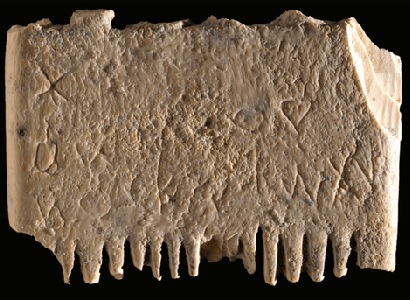Fangs lice and hair
Publish date 07-03-2023
 An elephant ivory comb was found during archaeological excavations in the Israeli city of Lachish. One side is engraved with the oldest known Canaanite sentence.
An elephant ivory comb was found during archaeological excavations in the Israeli city of Lachish. One side is engraved with the oldest known Canaanite sentence.
The city of Lachish has played a central role for millennia. It was an important Canaanite city-state in the 2nd millennium BC, the second city of the kingdom of Judea after Jerusalem and one of the major cities of the Persian era and of early Hellenism. Since 1932, seven excavation campaigns have involved the area, bringing to light the acropolis and the places of power. Near the stately building, in 2016 a well was found containing, together with other materials, a comb with the inscription, published in the scientific journal Jerusalem Journal of Archaeology.
The earliest phases of this alphabetic language are little known, and consist of isolated words. The comb of Lachish, on the other hand, contains a complete verbal sentence, a feature that allows you to resolve some grammatical and lexicological doubts. Linguistically, it is possible to compare some aspects of the Canaanite dialect of Lachish with those of other cities.
This is the first time that a Canaanite inscription written on a material datable with the Carbon 14 method has been found during a modern archaeological excavation, conducted with scientific methods. The dating of the object is therefore much more precise. Pending the completion of the analyses, it has been dated between 1200 and 1150 BC.
Another peculiarity is the content of the inscription, which tells of a daily aspect in the ancient world: the presence of lice in the hair or beard. The comb could be used from two sides: the side with the larger teeth to untangle knots from hair or beard, the side with the smaller teeth to remove lice. The head of a louse, preserved over the centuries, was also found between two of these teeth. Finally, the typology of the inscription is also unusual: in this period, dedication or property inscriptions are common, while this refers to the function of the object.
Agnese Picco
NP December 2022







